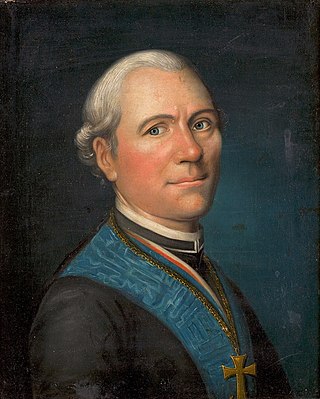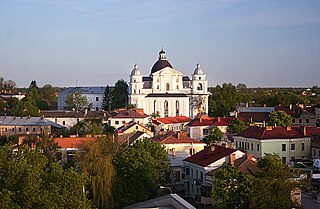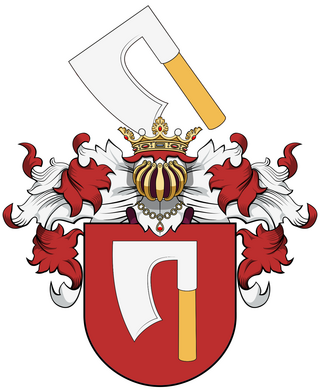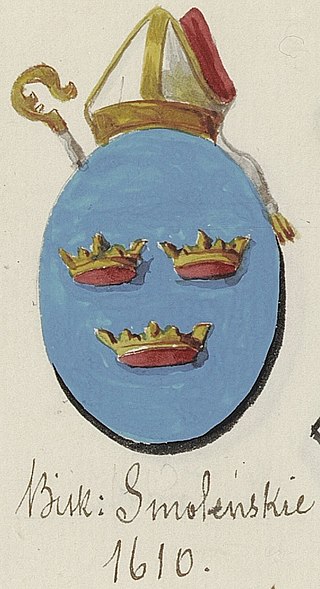
Czernihów (Chernihiv) Voivodeship was a unit of administrative division and local government in the Kingdom of Poland from 1635 until Khmelnytsky Uprising in 1648. Also it was used as a fictitious title in the Commonwealth until the Partitions of Poland in 1772/1795. In 1635, Marcin Kalinowski was the first voivode (governor) of the Chernihiv Voivodeship.

Minsk Voivodeship was a unit of administrative division and local government in Grand Duchy of Lithuania since 1566 and later in Polish–Lithuanian Commonwealth, until the partitions of the Commonwealth in 1793. Centred on the city of Minsk and subordinate to the Grand Duchy of Lithuania, the region continued the traditions – and shared the borders – of several previously existing units of administrative division, notably a separate Duchy of Minsk, annexed by Lithuania in the 13th century. It was replaced with Minsk Governorate in 1793.

Brest Litovsk Voivodeship was a unit of administrative territorial division and a seat of local government (voivode) within the Grand Duchy of Lithuania since 1566 until the May Constitution in 1791, and from 1791 to 1795 as a voivodeship in Poland. It was constituted from Brest-Litovsk and Pinsk counties.

The House of Sapieha is a Polish-Lithuanian noble and magnate family of Ruthenian origin, descending from the medieval boyars of Smolensk and Polotsk. The family acquired great influence and wealth in the Polish–Lithuanian Commonwealth during the 16th century.

Adam Stanisław Naruszewicz was a Polish-Lithuanian nobleman, poet, historian, dramatist, translator, publicist, Jesuit and Roman Catholic bishop.

The Roman Catholic Diocese of Lutsk was first established in the 13th century as the diocese of Luceoria (Latin) or Łuck (Polish). After the victory of Napoleon, the diocese was joined with the Diocese of Zhytomyr, forming the diocese of Lutzk-Zhitomir-Kamenetz. In 1925, the diocese of Lutsk was restored and the Diocese of Zhytomyr became separate.
Bishops of Vilnius diocese from 1388 and archdiocese from 1925:

The Metropolitan Archdiocese of Kaunas is a Latin Church ecclesiastical territory or archdiocese of the Catholic Church in Lithuania. The episcopal see is in Kaunas, the second-largest city in Lithuania. The archdiocese's motherchurch and cathedral is Kaunas Cathedral Basilica; it is also home to a Minor Basilica in a town of Šiluva, in the region of Samogitia.
These are lists of bishops of the Przemyśl archdiocese.

The Diocese of Włocławek is a Latin Church ecclesiastical territory or diocese of the Catholic Church in Poland. It is a suffragan in the ecclesiastical province of the Metropolitan Archdiocese of Gniezno. Until the 20th century, it was known as the Diocese of Kujawy.

Tarło was a Polish magnate (szlachta) family. The seats of the family in the 16th century were, among others: Laszki Murowane near Chyrów, Sambor, Dębowiec near Jasło, Samoklęski and Potok near Krosno.

The Diocese of Smolensk was a Latin Church ecclesiastical territory or diocese of the Catholic Church. Founded in 1636 and dissolved in 1818, it was initially located within the Polish–Lithuanian Commonwealth, and later in Czarist Russia.

Rectors of the Jagiellonian University – List of rectors of the Jagiellonian University, known also as the Cracow Academy, University of Cracow, and Szkoła Główna Koronna. The list begins in 1400 at the restoration of the university under Jadwiga of Poland and Władysław II Jagiełło.

Clan Ostoja (Moscics) is one of the largest and oldest knightly and heraldic families in Europe, belonging to the Polish nobility. The family is sealed with the Ostoja coat of arms.











